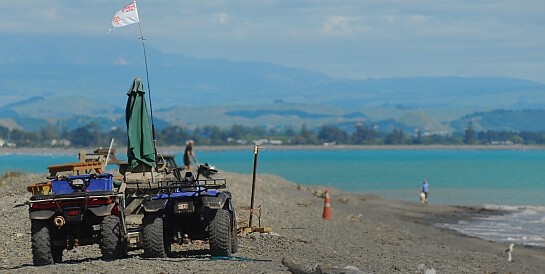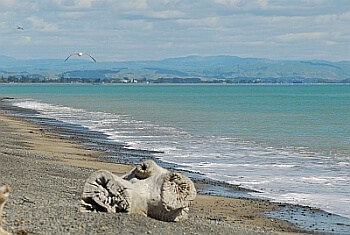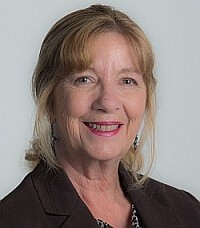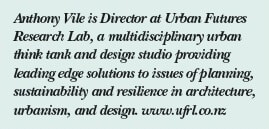What is it with the coast? Why is it some people just end up ‘going coastal’? Some primeval urge to be near the sea? The sound of waves bouncing around in our unconscious, echoes of primeval origins.
The line between land and sea remains tenuous at best. At times welcoming, at others plain frightening … think Anzac Cove or media footage of the Japanese tsunami.
The foreshore is the place where life emerged from a fermenting stew of primordial soup, where cultures collided, where the Queen’s chain rattles. The horizon is an omnipresent temptation to travel further, to reach beyond, but also a reminder that the big one may not be so far away. It’s part of the Kiwi psyche. Aaah! Life at the coast … salty, noisy, prehistoric.
When moving to Hawke’s Bay three years ago it seemed so obvious. Post-global financial meltdown, urbanity didn’t hold too much appeal measured against an option at the seaside. Why didn’t everyone else do it? They do on the Gold Coast. Was there some hidden catch?
The specific sound of the Te Awanga surf amplified by the rolling shingle stuck on rinse cycle tapping out an endless rhythm, white noise of the most natural kind. It creates an amplified sense of place.
Research shows that the sound of waves alters wave patterns in the brain, lulling you into a deeply relaxed state. Relaxing in this way can help rejuvenate the mind and body.
Supporting the sound, the sea air is full of negative hydrogen ions, charged particles that improve our ability to absorb oxygen by neutralizing damaging free radicals (positive ions). These negative ions can also balance levels of serotonin, the feel good hormone, making us less prone to anxiety … hence the popularity of seaside holidays and coastal occupation.
A feeling perhaps shared by the venerable James Cook, who visiting what he came to name as Cape Kidnappers on 15th October 1769 was moved to write in his diary the following account:
“…the Indian Boy Tiata, Tupia’s servant, being over the side, they seized hold of him, pulld him into the boat and endeavourd to carry him off, this obliged us to fire upon them which gave the Boy an opportunity to jump over board and we brought the Ship too, lower’d a boat into the Water and took him up unhurt. Two or Three paid for this daring attempt with the loss of their lives and many more would have suffered had it been for fear of killing the boy—. This affair occation’d my giveing this point of Land the name of Cape Kidnappers: it is remarkable on account of two white rocks in form of Hay Stacks Standing very near it: on each side of the Cape are tollerable high white steep clifts.
The southern-most curve of Te Matau O Māui – The hook of Māui – is named Cape Kidnappers but could equally have been named ‘Cape Rescue’ depending on which side of the story you sit. Perhaps a metaphor for the present situation.
Today, the Cape Coast refers to the stretch of coastline extending from Haumoana to Clifton. A unique place, resplendent with natural beauty, cemented in the history of Aotearoa not only by the first European explorers, but by Māui himself, his hook now a permanent feature defining the geography of the bay. The Cape Coast rich in heritage of national significance no doubt.
Those first to occupy the land, the fauna of prehistory, came from the sky, the birds that feature strongly in the iconography of the place and the coast story. The infamous gannets continue to journey here for a yearly stopover, attracting tourist dollars along with them.
The second wave of occupants were human, settling in Te Awanga overlooking the Maraetotara river and the sea, safe in elevation. Occupation at Tiromoana Pa has been carbon dated as far back as the 11th century, one of the earliest identified settlements in the country.
The Cape Coast is now home to a vibrant, diverse, creative community who for whatever reasons have chosen to domicile on this thin strip of dirt. A strip of dirt much maligned and misunderstood by bureaucrats, battered by the elements, loved by locals, tourists, foodies, explorers and day-trippers … an asset to the region.
In a certain sense there is a great freedom in being a coast dweller … Black Bridge demarking the point of no return. Freedom to unwind on a daily basis, to wander the shoreline, to collect treasures, encouraging a child-like freedom to dream.
So what is the collective dream for the coast? Is there one? Does it need one? Is the place fine just how it is, or could there be improvements? If so, what needs to happen and who is steering the waka?
The coast in a word: dynamic
In reality the Cape Coast is a truly unique piece of NZ landscape and culture that deserves a genuine commitment from those in positions of public trust bestowed with the responsibility of kaitiakitanga. Commitment to creating solutions to some endemic problems in order that confidence and investment in the area can be reignited.
The coast in one word is dynamic. Not just the physical nature of the landscape and ecology, but the people who have been attracted to life on the edge, sea level rise be damned, a glass of blush in hand, a crayfish passed over a fence, just don’t drop in on my wave and we’ll all get along.
The floating trailer is a unique invention; its cultural value needs to be celebrated. It is representative of the type of character who lives on the coast and the type of solutions that can be found for unique problems. The old-school Burt Munroe approach to getting things done. Just do it, make it work and get on with it.
I don’t know how many reports have been commissioned over the years to address coastal issues. The coast is a dynamic living ecology. It is a natural system that is in perpetual state of flux forever looking to achieve balance. As such, it is as much a part of the rivers that feed the Bay as it is a part of the ocean ecology and its cycles of tides and weather. It bridges the worlds of land and sea and as such supports life in a thin precarious strip.
A report commissioned by the Regional Council, to be released to the public in January, confirming heightened expectations of sea level rise, will highlight the risks involved in not proactively managing the coastal environment in a holistic fashion.
One elephant in the room when it comes to coastal erosion is the quarrying of shingle at Awatoto. The report highlights the significant impact of this activity on the southern coast. Winstone Aggregates has secured resource consents for gravel extraction till 2017. This will help satisfy the annual demand of every New Zealander for eight tonnes of aggregates. The issue of gravel extraction has been skirted around in other reports over the years, but it seems only natural that if you remove 30,000 cubic metres of shingle from Awatoto, maybe another 30,000 cubic metres might want to fill that hole!
Walk on Water (WOW) chairperson Ann Redstone asks why HBRC has just allowed Awatoto to roll over its consent for extraction to 2017, “when it knew eight years ago this and heavy river extraction was impacting the Haumoana coastline?”
Perhaps what is needed for the coast is a regional paradigm shift. Professor Paul Komar, professor emeritus from the ocean sciences college of Oregon State University, who as a HBRC consultant has studied our coast more than most, offers one:
“Putting a stop to extraction would mean the coast would stabilise the gravel beaches south of Napier as far as Haumoana … The beach is the buffer. You want as strong a buffer as possible between you and the rising sea levels. It just makes sense not to extract gravel from the sand and beaches.”
If the aggressive mining of the coastal shingle is partly responsible for coastal erosion on the Cape Coast, then what of the plans for the Ruataniwha dam? The rivers cannot be separated from the ecology of the coast. They are one and the same.
The sooner the paradigm shifts to embrace a whole system approach to environmental management, the sooner we can start emptying those tourists’ pockets of their cash. It has to be an easier way of milking foreign currency than connecting Betsy to the milking machine every morning and evening.
Turning worst case into best
New Zealand has 14,000 kilometres of coastline, the tenth-longest in the world. Hawke’s Bay has 353 kilometres. There is no doubt that with sea level rise imminent, coastal management is not only a regional issue, but a national imperative. With one metre of sea level rise now forecast by 2100, we will need some significant Burt Munroe-style innovation. There is no time like the present.
The New Zealand Coastal Policy Statement (NZCPS) directs district and regional councils on how to manage the coast in their jurisdiction. That policy, as excerpted below, sets the stage for how local and regional government has missed the mark historically when it comes to delivery of what these bodies are charged with … guardianship.
NZCPS Policy 15: Natural features and natural landscapes
To protect the natural features and natural landscapes (including seascapes) of the coastal environment from inappropriate subdivision, use, and development:
Recognise that tangata whenua have traditional and continuing cultural relationships with areas of the coastal environment, including places where they have lived and fished for generations.
A long conversation with Darkie (Mick) Unahi, 83-year-old kaumatua from Matahiwi Marae, and Jacob Scott, both long-term residents of Haumoana with whänau connections back generations, brings alive the richness and complexity of the history of the Haumoana/Te Awanga area. The lack of sympathy for local knowledge regarding management of the environment over the years is astounding. Who better to contribute to the understanding of the ecology than those who have witnessed it over a lifetime, in conjunction with inherited stories stretching generations.
“The river was our supermarket. We didn’t need to go into the shops. The fish we caught fed Pākehā families as well as Māori,” says Darkie Unahi.
NZCPS Policy 27: Strategies for protecting significant existing development from coastal hazard risk
…recognizing that hard protection structures may be the only practical means to protect existing infrastructure of national or regional importance, to sustain the potential of built physical resources to meet the reasonably foreseeable needs of future generations…
The Regional Council and the Hastings District Council also have their own coastal policies – the Hawke’s Bay Regional Coastal Environment Plan and the Coastal Environment Strategy, respectively.
“Hastings District has an extensive coastline covering some 78 kilometres. The Coastal Environment contains a complex mix of natural and built features, as well as significant cultural, heritage and recreational values, which the Hastings community needs to manage in a comprehensive and sustainable manner.”
We are lucky to have in Hawke’s Bay a beautiful, enchanting landscape. The definition of landscape has come to include also culture. The sustainability of the culture of the coast is as vital as the landscape itself; the two cannot be separated. We are also lucky to have a district policy regarding ‘landscapes of significance’; the Cape Coast is highlighted as one. Significant not just because of the natural beauty, but for cultural reasons as well.
The imperative of any coastal protection policy is then one of cultural protection as well as land. Land is more tangible and easier to put a number on; culture is more difficult, yet the culture that the coast supports is readily evident on any day when the weather and the tides are cooperating. Surfing, fishing, kai gathering, beach fires, playing cricket, riding quad bikes, horses, cycles and motorcycles, or just going for a walk.
But sadly, instead of being seen as a natural regional playground, the Haumoana to Clifton coast is used in a university-level geography class as an illustration of how things can go horribly wrong with process. If progress is to be made, there needs to be a breakthrough in what seems to have become a stalemate. Meetings being undertaken for the community planning process have not been well attended; perhaps something tantamount to coast issue and consultation burnout is occurring. Just as the sea cannot breach a well-engineered wall, the local community has not over the years surmounted the formidable council decision-making processes.
The question is now how to reinvent the process as an example of best case, not worst. The value of intergenerational local knowledge about a place cannot be underestimated. Stories, common sense and tested solutions are where discussions need to start.
Perfect opportunity
The coastal management, planning and policy space is very busy on the Cape Coast at the minute.
Community plans are being authored; subdivision and development plans refined. There seems to be a perfect storm of opportunity brewing that may provide the catalyst to put aside any bad blood that has been generated over the years and deal once and for all proactively and collaboratively with the key issues that need to be resolved on the Cape Coast. Now is an opportunity for an integrated, inclusive push with a ‘Yes, we can!’ approach to getting things done.
Much planning is in process, with many inter-related issues and activities on the table:
- The ongoing debate over coastal erosion, gravel extraction, and the groynes.
- The Ruataniwha dam and potential effect on the bay of Tukituki River flows and health.
- The Hastings District Plan review proposing rubber-stamping areas for development both in Te Awanga and Haumoana.
- Master plans and design controls required for proposed development areas.
- The HDC community plan currently being authored as a non-statutory guide to frame community led actions and projects, including closer relationships with Matahiwi Marae and an art and heritage trail along the cycle track.
- Work to preserve road access to Clifton Motor Camp and the boat ramp.
- The possibility of a managed retreat or relocation of the Clifton camp to a nearby location.
- Ongoing resilience of septic tank systems as waste management.
- Continued work on the National Cycleway running through the area.
- Consistent spectacular output from local vineyards and associated restaurants.
- Ongoing coastal access to Cape Kidnappers itself and the gannet colony.
- The fabulous species restoration work at the Cape Sanctuary project.
- The Clifton Country Cricket Club planting of natives at their home turf and building impressive community spirit in the hills behind Te Awanga.
Coastal dreaming
What is the collective dream for the coast? Walk on Water (WOW) and the Cape Coast Community Group (CCCG), with wide community support, in 2010 created a strategic vision for the coast. The document was used as a submission to the Hastings Council’s Long Term Plan. It included a rebranding of Haumoana, Te Awanga, Clifton and Cape Kidnappers under the descriptive term ‘The Cape Coast – Giving Hawke’s Bay an Edge’.
WOW has worked tirelessly to develop the profile for the community, as well as solutions to the biggest elephant in the room – coastal erosion and hard engineering as an effective and economic solution. WOW’s Ann Redstone says the group has got the cost down from “ridiculous” estimates of up to $40 million to around $8 million, including a $4 million contribution from Hastings District Council as a trade-off for not having to re-route access and replace infrastructure.
The basic premise of the WOW group needs to be the basis of further action:
The Cape Coast is a regional recreational asset, used by people from all across Hawke’s Bay and is a prime visitor location. It has a rich and colourful past steeped in Māori and European history and an amazing future as a centre for tourism, hospitality and the creative arts if it is given the chance to show its true potential.
The key words are ‘regional’ and ‘potential’. The WOW document maintains its legitimacy and thankfully now can be incorporated into the community planning process. For WOW spokesman Keith Newman, the biggest issue is coastal protection, including WOW’s well-developed plan for a groynefield protecting the area from Cape View Corner to the Tukituki river mouth. The key to achieving this is recognition of the regional value and importance of the coast.
Meanwhile, there has been no real major storm event since Easter 2010 and thus no real media coverage of life out here on the edge. Summer is upon us with long enjoyable days by, in or on the sea. The boat ramp is open again and kai stocks have been replenished. Increasing numbers of bikers roll past on a weekly basis. Properties continue to come on the market and sell. Insurance companies are still dubious about some high-risk properties on the wrong side of the invisible lines demarking the coastal hazard zones.
“One of the factors that can influence price is a perception that a property is affected by a stigma, in the case of Hawke’s Bay coastal property the influence of Coastal Hazard Zones potential effects on property rights.”, according to the HBRC coastal value report.
The tide comes in and goes out. The gentle waves lull us into a sense of security. The inevitable consequences of sea level rise and changing weather patterns parked out of mind for now. Let’s hope that between now and the next ‘event’ a positive pathway for the coastal community and the authorities to work through their differences is charted.







